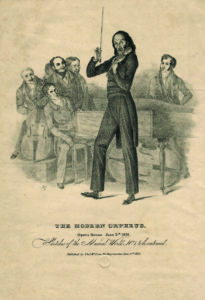
November 6, 2017
Paganini’s Theme
Niccolò Paganini was perhaps the most influential violinist in the history of music. His tours across Europe from 1829-1834 astonished audiences; many of his compositions were so difficult that initially only he could play them. He not only revolutionized violin playing, but also inspired composers that followed him to make virtuoso technique a central part of the classical music tradition. A contemporary history of the violin described him thus:

“Audacious in his experiments on the capacity of his instrument, yet refined to the extreme of subtlety; scientific, yet wild to the verge of extravagance…his tall, gaunt figure, his long fleshless fingers, his wild eager and wan visage, his thin grey locks falling over his shoulders, and his singular smile sometimes bitter and convulsive, always strange, made up an aspect which approached nearly to the spectral.”
Even during his life, a legend that he had sold his soul to the devil in exchange for his preternatural abilities was widespread. Paganini himself claimed that his talent came from a guardian angel, but his uncanny mien and infamous womanizing somewhat undercut his position. In any case, the legend likely sold more tickets.
Perhaps Paganini’s most celebrated original works were his 24 Caprices for solo violin, the last of which was a theme and variations:
The simple tune that began it became a symbol of virtuoso technique, inspiring many composers (including Liszt, Schumann and Brahms) to use it as the basis of their own fiendishly difficult variations. This November, the Houston Symphony presents works by three composers who were inspired by Paganini’s legendary theme: Lutosławski, Blacher and Rachmaninoff.
Lutosławski’s Paganini Variations for Solo Piano and Orchestra
Polish composer Witold Lutosławski was no stranger to the vagaries of the 20th century. A member of the Polish gentry, Lutosławski’s father sided with the Whites during the Russian revolution and was executed by the Reds when Lutosławski was five years old. Later, Lutosławski served in the Polish military during Poland’s brief attempt to resist the Nazi invasion, during which he was captured and imprisoned. Fortunately, he escaped after eight days in captivity and managed to eke out an existence playing piano in Warsaw’s cabarets during the war, as concert halls had been closed to Polish composers. During this period he formed a piano duet with fellow composer Andrzej Panufnik. He later recalled the dangerous situation:
“When the Nazis entered Warsaw, Polish music stopped. After the Jews and gypsies, we Slavs were hated most by them. They took over our orchestras, kept most of the Polish musicians, but German conductors and repertory were imported. Poles boycotted their concerts but we arranged clandestine meetings in rooms, daring imprisonment to play chamber music or premiere some of our things.”
Of approximately 200 compositions and arrangements from this period, the Paganini Variations in its original version for two pianos was the sole survivor, as it was the only one Lutosławski took with him before the allied bombing of Warsaw:
https://www.youtube.com/watch?v=M0uJvYjNY9k&t=1m32s
Lutosławski followed Paganini’s original set of variations quite closely: Paganini’s set featured 11 variations with a coda, and Lutosławski’s features 12 (the last replaces the coda). Nearly all of Lutosławski’s variations use the melodic figuration of the corresponding Paganini variations while radically changing harmonies and textures. The result is incredibly ingenious, revealing hidden possibilities unrealized in Paganini’s original work.
Lutosławski’s original two-piano version was, like Paganini’s original, only about five minutes long, but when Lutosławski reworked it for piano and orchestra, he cleverly extended it by repeating most of the variations: the second time around, the piano and orchestra switch parts. Throughout, the orchestration is luminous and resonant, fully exploiting Lutosławski’s rich, complex harmonies. True to the spirit of Paganini, virtuoso technique is on full display to exhilarating effect.
One variation offers the musicians some respite about halfway through; the tempo slows, and the piano and orchestra engage in an exquisite duet. Careful listeners will notice that the orchestra plays the mirror image of the piano’s melody—it is the same line, but inverted (what went up instead goes down) and offset by a beat. The remaining variations bring the work to a thrilling conclusion.
Blacher’s Orchestral Variations on a Theme of Niccolò Paganini, Opus 26
Born in Manchuria to an Estonian father and German mother, Boris Blacher grew up in Siberia and northeastern China before moving to Berlin to study mathematics and architecture in 1922; however, he soon changed his focus to music. With an emphasis on color and extended tonal harmonies, his compositions show influence from the French school of modernism. His career was put on hold when the Nazis took power in 1939 and declared his music “degenerate.” Fortunately, he survived this persecution and became an influential teacher of composition in post-war West Germany.
The Orchestral Variations on a Theme of Niccolò Paganini of 1947 quickly became his most popular work. It begins with the theme played by a solo violin, just as it appears in Paganini’s original Caprice, before launching into 16 virtuoso variations for the orchestra:
The variations traverse a wide range of moods, from quiet ruminations to bombastic frenzy. Each of the woodwinds has at least one major solo, and one notable variation about halfway through features pizzicato strings. The influence of jazz and popular dance forms can be frequently heard in walking basslines, hazy harmonies and propulsive rhythms, especially in the wild crescendo of the final variation.
The last piece on the program is Rachmaninoff’s beloved Rhapsody on a Theme of Paganini. Check back soon for our next post, which details Rachmaninoff’s secret program for this concert hall staple.
Don’t miss these Paganini-inspired works November 17, 18 & 19 at Jones Hall! Get tickets and more info at houstonsymphony.org.






